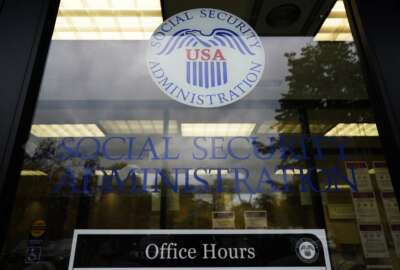OMB prepares for open gov sites to go dark in May
Several sites, including Data.gov, the IT Dashboard and the FEDRamp cloud efforts, could be shut down in the next two months if the administration doesn\'t get ...
wfedstaff | June 3, 2015 11:07 pm
By Jason Miller
Executive Editor
Federal News Radio
Many of the Obama administration’s top open government initiatives are set to be turned off by May 31.
Government sources confirm that the Office of Management and Budget is planning to take seven websites dark in two months because of a lack of funding.
One government official, who requested anonymity because they didn’t get permission to discuss the topic, said funding will begin to run out on April 20 for public sites IT Dashboard, Data.gov and paymentaccuracy.gov. The source said OMB also is planning on shutting down internal government sites, including Performance.gov, FedSpace and many of the efforts related the FEDRamp cloud computing cybersecurity effort.
The official said two other sites, USASpending.gov and Apps.gov/now, will run through July 30 but go dark soon after.
“We need at least another $4 million just to keep USASpending.gov operating this year,” the official said. “We are looking at a pass-the-hat approach, but it could be challenging to get that done in time.”
The White House requested $35 million for the e-government fund in 2011. The House allocated only $2 million in its bill, H.R. 1. The Senate, meanwhile, would provide $20 million for the e-government fund.
“The continuing resolution says we can only spend what we would reasonably expect to get during the fiscal year, and we have no reasonable expectation to get more than a couple of millions of dollars,” the source said.
OMB and the General Services Administration, which manages the e-gov fund, already spent $1.63 million last fall on the recipient reporting feature of USASpending.gov.
OMB and GSA now can only spend $370,000 the rest of the year on these initiatives.
A request to OMB for comment on the sites going dark was not returned.
Proposed cuts to e-gov despite cost-savings
Federal Chief Information Officer Vivek Kundra said recently that the IT Dashboard has helped save the government $3 billion on IT projects.
“Using this important tool, we identified underperforming high priority IT projects and began an intensive review of these programs, eliminating ineffective projects, reconfiguring others, and targeting IT expenditures more carefully,” he said in a video promoting the IT Dashboard’s benefits.
The lack of House support for e-government also doesn’t bode well for the administration’s $50 million request for the Integrated, Efficient, and Effective Uses of Information Technology (IEEUIT) program. The Senate approved $40 million in its version of the 2011 spending bill. The House doesn’t discuss this fund specifically.
Kundra said in a March 17 hearing before the House Appropriations Subcommittee on Financial Services and General Government that the IEEUIT fund is devoted on cracking down on duplicative systems and increasing the number of large scale IT projects they are reviewing.
Kundra announced Thursday that OMB is moving to an open source model for the IT Dashboard and for the TechStat toolkit. Kundra did not say if the budget was part of the reason for the move-only that he wants to tap into the collective ideas to improve both tools and other governments want to implement these processes.
“The detrimental effect of HR 1 on so many areas of government is clear—and perhaps no more so than on the efforts to ensure the government’s IT infrastructure upgrades are proceeding on schedule and on budget,” said Rep. Jose Serrano (D-N.Y.), ranking member of the House Appropriations Subcommittee on Financial Services and General Government. “We cannot have a more streamlined, efficient and open government without using the best technology available. Unfortunately the cuts in H.R. 1 to e-government fund will have the unintended consequence of making government less accountable and transparent.”
Requests for comment to the chairman of the House Appropriations Committee were not returned.
Pro-transparency groups fight cuts
Several industry and good government groups have been trying to drum up support for these e-government initiatives.
The Sunlight Foundation sent a letter to House and Senate appropriators as well as each chamber’s leadership explaining why these programs are so important.
“Basically what the letter says is this is the way to find out what’s going on in Congress, this is the way to find out where tax dollars going and this way to figure out what the government is doing,” said Daniel Schuman, a policy counsel with Sunlight, during an interview on In Depth with Francis Rose Wednesday.
He said that if the sites go dark, the data will eventually go out of date and the efforts to clean up and make the information more useful also will stop.
“If it were to go away, agencies could perhaps post the information on their website,” Schuman said. “But because of the way government websites are set up, it could be difficult or impossible for people to access information they’ve already grown accustomed to using. A lot of people built programs to gather information from Data.gov, and they would have to go back and rework what they do.”
The White House is reaching out to members on the Hill.
“It’s been an annual challenge to get congressional support for the e-government fund,” said Tim Young, a former OMB official and now a senior manager with Deloitte Consulting. “One of reasons that it’s been challenging in getting the e-government fund fully appropriated is what some say are a void in the tangible political constituency. Some in Congress say it’s a nice to have but an unnecessary fund.”
He added that the benefits of the programs are realized across the government but because the money is not given to a specific program or agency, there are some who argue that dilutes the benefits of the programs.
Sen. Joseph Lieberman (I-Conn.), the author of the E-Government Act of 2003, which created the e-gov fund, has long been a steady supporter of Congress providing full funding.
“Economic conditions demand wise budget decisions, but cutting money from multiple federal IT programs is penny-wise and pound foolish,” said Leslie Phillips, a spokeswoman for the Senate Homeland Security and Governmental Affairs Committee, which Lieberman is the chairman of. “Programs that modernize technology ultimately improve management and save taxpayers billions of dollars. Transparency and e-government programs encourage public participation in government. Small investments in IT modernization can reap enormous rewards, which is why Senator Lieberman opposes the proposed cuts to the e-gov fund and the administration’s IT reform efforts.”
Young said cutting the funding in the short term will cost the government in the long run.
“Inconsistency in funding has a potential negative impact especially if agencies are meeting fixed schedules or deployments,” he said. “In many cases, changes to the schedule increases the government’s costs.”
Others say despite bipartisan support, it’s still a matter of educating the appropriators about the benefits of these sites.
“Generally there have been many criticisms about the quality of data but at this stage of the effort, two years in, what’s happening if you terminate these sites the ability to improve the quality of information and information vendors are seeking will be completely eliminated,” said Fred Corle, senior director for strategic marketing at KGS, Inc. “Clearly with the budget situation and election in November, there are pressures put upon Congress to balance the budget or at least move in that direction and that is a major driver. But there are certainly some merits to providing this kind of information.”
Corle added the potential shutdown of the USASpending site would have a big impact on the government’s transparency efforts as well as on vendors.
“There has been a lot of work in terms of data quality and pulling sites down at this stage of evolution would stunt it,” he said.
Young said if the IT Dashboard goes dark it would have a significant impact on oversight of the $80 billion IT budget.
“It’s a small investment, maybe $2 million or $3 million to help provide oversight of $80 billion,” he said. “I’d expect in the mid-term that some of those oversight responsibilities will go away and a lack of accountability at the program level may ensue.”
Budget constraints at odds with e-gov efforts
Dan Chenok, a former OMB official and now a senior fellow with IBM’s Center for the Business of Government, said the administration remains committed to a transparency and open government agenda, but it’s getting caught up in the budget constraints.
Chenok said if the funding gets cut there are several other ways OMB could ensure these sites are kept running.
“As for other options, I’m not sure what is being considered, but historically there have been other manners and methods to use funding to support activities,” he said. “These include interagency transfers under the Economy Act, working capital funds, carry over support from multi-year funding for technology and additionally vehicles that could be used. The administration would have to work with Congress and other stakeholders to make them work.”
Young said what OMB does should the sites go dark will be interesting.
“What would be telling if these cuts endure,” he said. “Will OMB make an attempt to fund through alternative sources such as interagency funding through the CIO or CFO councils, or will agencies take ownership of certain programs until the funding can be restored?”
Schuman and others say a lot depends on what comes from the latest efforts to keep the government running past April 8. Budget discussions between the White House and Congress are advancing and could include $33 billion in reductions.
(Copyright 2011 by FederalNewsRadio.com. All Rights Reserved.)
Copyright © 2024 Federal News Network. All rights reserved. This website is not intended for users located within the European Economic Area.





